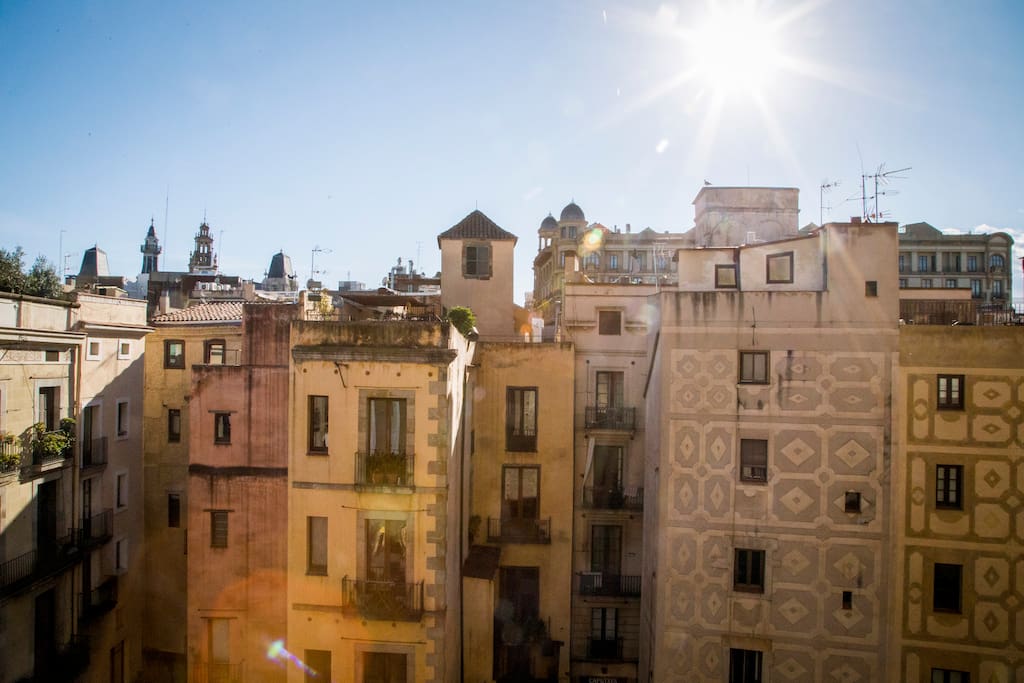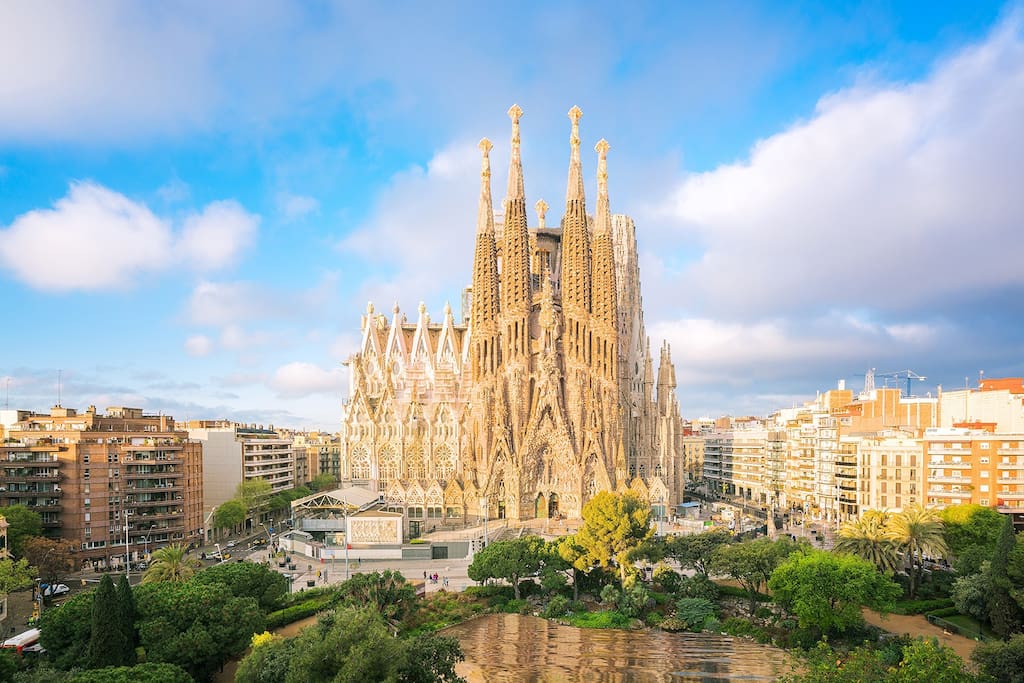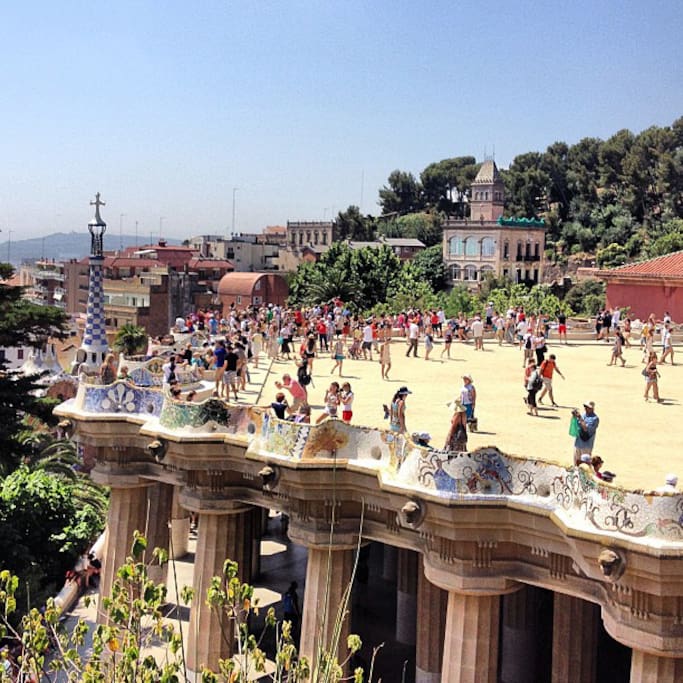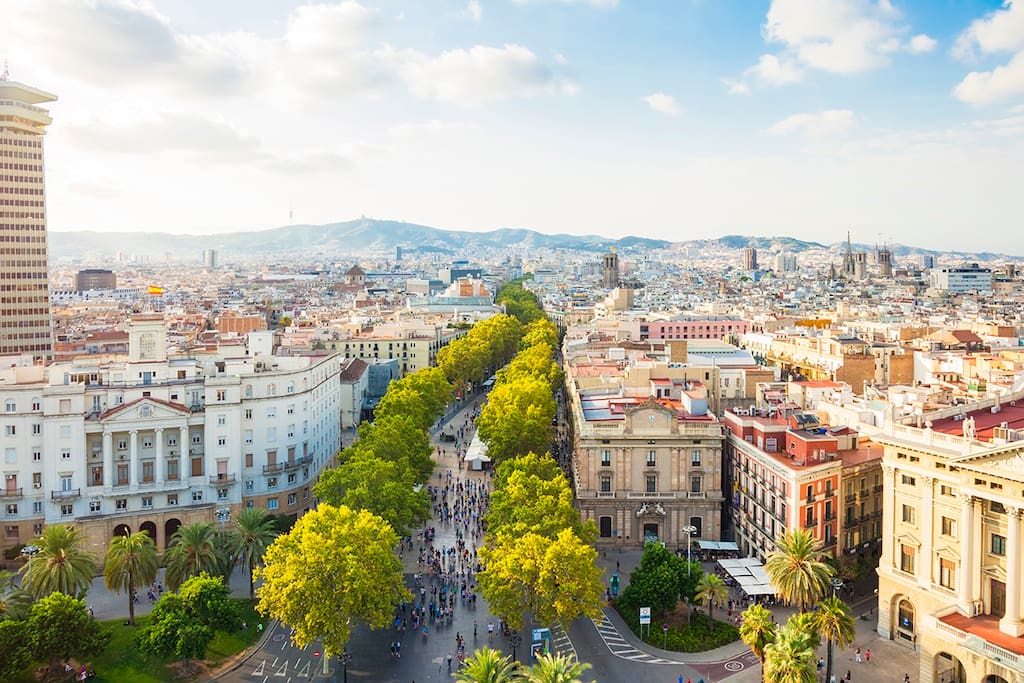Barris
The former market hall Mercat del Born covers archaeological ruins which were part of the La Ribera district that was demolished after the Siege of Barcelona (1713–14) and the defeat of Catalonia in the War of Succession. Another place of interest is the Fossar de les Moreres, the site of a mass grave of Catalan soldiers fallen during the siege of 1714. Part of the quarter of La Ribera was demolished after 1714 to build a military citadel to punish the defeated city. It is also a nice place to walk around and have some drinks!
169 personas locales recomiendan
El Born
The former market hall Mercat del Born covers archaeological ruins which were part of the La Ribera district that was demolished after the Siege of Barcelona (1713–14) and the defeat of Catalonia in the War of Succession. Another place of interest is the Fossar de les Moreres, the site of a mass grave of Catalan soldiers fallen during the siege of 1714. Part of the quarter of La Ribera was demolished after 1714 to build a military citadel to punish the defeated city. It is also a nice place to walk around and have some drinks!
Gràcia is a district of the city of Barcelona. A vibrant and diverse enclave of Catalan life, Gràcia was an independent municipality for centuries before being formally annexed by Barcelona in 1897 as a part of the city's expansion.
119 personas locales recomiendan
Gràcia
Gràcia is a district of the city of Barcelona. A vibrant and diverse enclave of Catalan life, Gràcia was an independent municipality for centuries before being formally annexed by Barcelona in 1897 as a part of the city's expansion.
The quarter encompasses the oldest parts of the city of Barcelona, and includes the remains of the city's Roman wall and several notable medieval landmarks.[1] Much of the present-day fabric of the quarter, however, dates to the 19th and early 20th centuries.[citation needed] El Call, the medieval Jewish quarter, is located within this area, along with the former Sinagoga Major.[2]
The Barri Gòtic retains a labyrinthine street plan, with many small streets opening out into squares. Most of the quarter is closed to regular traffic although open to service vehicles and taxis.
81 personas locales recomiendan
Gothic Quarter
The quarter encompasses the oldest parts of the city of Barcelona, and includes the remains of the city's Roman wall and several notable medieval landmarks.[1] Much of the present-day fabric of the quarter, however, dates to the 19th and early 20th centuries.[citation needed] El Call, the medieval Jewish quarter, is located within this area, along with the former Sinagoga Major.[2]
The Barri Gòtic retains a labyrinthine street plan, with many small streets opening out into squares. Most of the quarter is closed to regular traffic although open to service vehicles and taxis.
El Poblenou, Catalan for "new village", is an extensive neighborhood of Barcelona (Sant Martí district) that borders the Mediterranean sea to the south, Sant Adrià del Besòs to the east, Parc de la Ciutadella in Ciutat Vella to the west, and Horta-Guinardó and Sant Andreu to the north. It is technically part of the Eixample, its layout having been drafted by Ildefons Cerdà, although the historic center of the neighborhood (which was once a town entirely separated from Barcelona) predates the grid.
94 personas locales recomiendan
El Poblenou
El Poblenou, Catalan for "new village", is an extensive neighborhood of Barcelona (Sant Martí district) that borders the Mediterranean sea to the south, Sant Adrià del Besòs to the east, Parc de la Ciutadella in Ciutat Vella to the west, and Horta-Guinardó and Sant Andreu to the north. It is technically part of the Eixample, its layout having been drafted by Ildefons Cerdà, although the historic center of the neighborhood (which was once a town entirely separated from Barcelona) predates the grid.
The Eixample is characterized by long straight streets, a strict grid pattern crossed by wide avenues, and square blocks with chamfered corners (named illes in Catalan, manzanas in Spanish).[2] This was a visionary, pioneering design by Ildefons Cerdà, who considered traffic and transport along with sunlight and ventilation in coming up with his characteristic octagonal blocks, where the streets broaden at every intersection making for greater visibility, better ventilation and (today) some short-term parking areas. The grid pattern remains as a hallmark of Barcelona, but many of his other provisions were ignored: the four sides of the blocks and the inner space were built instead of the planned two or three sides around a garden; the streets were narrower; only one of the two diagonal avenues was carried out; the inhabitants were of a higher class than the mixed composition dreamed of by Cerdà.[2] The important needs of the inhabitants were incorporated into his plan, which called for markets, schools, hospitals every so many blocks. Today, most of the markets remain open in the spots they have been from the beginning[citation needed].
Some parts of the Eixample were influenced by Modernista architects, chief among whom was Antoni Gaudí. His work in the Eixample includes the Casa Milà (nicknamed La Pedrera) and the Casa Batlló, both of which are on the wide Passeig de Gràcia, as well as the Sagrada Família. Other architects who made highly significant, and certainly more numerous, contributions to giving the Eixample its characteristic appearance include Josep Puig i Cadafalch, Josep Domènech i Estapà, Josep Vilaseca i Casanovas and perhaps above all Enric Sagnier i Villavecchia, responsible for a total of over 500 buildings in the city (not all of them in the Eixample).
48 personas locales recomiendan
Eixample
The Eixample is characterized by long straight streets, a strict grid pattern crossed by wide avenues, and square blocks with chamfered corners (named illes in Catalan, manzanas in Spanish).[2] This was a visionary, pioneering design by Ildefons Cerdà, who considered traffic and transport along with sunlight and ventilation in coming up with his characteristic octagonal blocks, where the streets broaden at every intersection making for greater visibility, better ventilation and (today) some short-term parking areas. The grid pattern remains as a hallmark of Barcelona, but many of his other provisions were ignored: the four sides of the blocks and the inner space were built instead of the planned two or three sides around a garden; the streets were narrower; only one of the two diagonal avenues was carried out; the inhabitants were of a higher class than the mixed composition dreamed of by Cerdà.[2] The important needs of the inhabitants were incorporated into his plan, which called for markets, schools, hospitals every so many blocks. Today, most of the markets remain open in the spots they have been from the beginning[citation needed].
Some parts of the Eixample were influenced by Modernista architects, chief among whom was Antoni Gaudí. His work in the Eixample includes the Casa Milà (nicknamed La Pedrera) and the Casa Batlló, both of which are on the wide Passeig de Gràcia, as well as the Sagrada Família. Other architects who made highly significant, and certainly more numerous, contributions to giving the Eixample its characteristic appearance include Josep Puig i Cadafalch, Josep Domènech i Estapà, Josep Vilaseca i Casanovas and perhaps above all Enric Sagnier i Villavecchia, responsible for a total of over 500 buildings in the city (not all of them in the Eixample).
Sant Antoni is a neighborhood in the Eixample district of Barcelona, Catalonia. Its non-official centre, the marketplace of the same name—designed by Antoni Rovira i Trias and built between 1872 and 1882—is one of the oldest and most popular in the city, especially with the secondhand book stalls that surround the building Sunday mornings. It is bordered by the neighbourhoods of the L'Antiga Esquerra de l'Eixample (on the other side of Gran Via de les Corts Catalanes), the Raval (on the other side of Ronda de Sant Antoni), and Poble Sec (on the other side of Avinguda del Paral·lel). The streets of Sant Antoni follow the grid pattern prevalent in all of Eixample, except for a central thoroughfare, the Avinguda de Mistral, built on the site of an important medieval road which led out of Barcelona. Another well-known landmark of Sant Antoni is the bar called Els Tres Tombs, right next to the market.
82 personas locales recomiendan
Sant Antoni
Sant Antoni is a neighborhood in the Eixample district of Barcelona, Catalonia. Its non-official centre, the marketplace of the same name—designed by Antoni Rovira i Trias and built between 1872 and 1882—is one of the oldest and most popular in the city, especially with the secondhand book stalls that surround the building Sunday mornings. It is bordered by the neighbourhoods of the L'Antiga Esquerra de l'Eixample (on the other side of Gran Via de les Corts Catalanes), the Raval (on the other side of Ronda de Sant Antoni), and Poble Sec (on the other side of Avinguda del Paral·lel). The streets of Sant Antoni follow the grid pattern prevalent in all of Eixample, except for a central thoroughfare, the Avinguda de Mistral, built on the site of an important medieval road which led out of Barcelona. Another well-known landmark of Sant Antoni is the bar called Els Tres Tombs, right next to the market.
Turisme
La Barceloneta is known for its sandy beach (which made an appearance in Don Quixote, book 2) and its many restaurants and nightclubs along the boardwalk. Over the past several years the quality of the sand on the beach has become a source of continued controversy. In February 2008, the World Health Organization began an inquiry designed to ascertain whether the sand meets WHO beach health and safety guidelines.
With its modernity, La Barceloneta continues to inhabit the scent of salt and marine life. For many, this is considered a luxury. La Barceloneta also attracts many cruise ships to dock.
Amongst the attractions on Barceloneta's beach are German artist Rebecca Horn's "Homenatge a la Barceloneta" monument, and, where the beach gives way to the Port Olímpic, Frank Gehry's modern "Peix d'Or" sculpture.
49 personas locales recomiendan
La Barceloneta
La Barceloneta is known for its sandy beach (which made an appearance in Don Quixote, book 2) and its many restaurants and nightclubs along the boardwalk. Over the past several years the quality of the sand on the beach has become a source of continued controversy. In February 2008, the World Health Organization began an inquiry designed to ascertain whether the sand meets WHO beach health and safety guidelines.
With its modernity, La Barceloneta continues to inhabit the scent of salt and marine life. For many, this is considered a luxury. La Barceloneta also attracts many cruise ships to dock.
Amongst the attractions on Barceloneta's beach are German artist Rebecca Horn's "Homenatge a la Barceloneta" monument, and, where the beach gives way to the Port Olímpic, Frank Gehry's modern "Peix d'Or" sculpture.
The Basílica de la Sagrada Família (Catalan for 'Basilica of the Holy Family'), also known as the Sagrada Família, is a large unfinished Roman Catholic minor basilica in Barcelona. Designed by Catalan architect Antoni Gaudí (1852–1926), his work on the building is part of a UNESCO World Heritage Site. On 7 November 2010, Pope Benedict XVI consecrated the church and proclaimed it a minor basilica.
On 19 March 1882, construction of the Sagrada Família began under architect Francisco de Paula del Villar. In 1883, when Villar resigned,[4] Gaudí took over as chief architect, transforming the project with his architectural and engineering style, combining Gothic and curvilinear Art Nouveau forms. Gaudí devoted the remainder of his life to the project, and he is buried in the crypt. At the time of his death in 1926, less than a quarter of the project was complete.
3229 personas locales recomiendan
La Sagrada Cerveseria
16 Plaça Sagrada FamíliaThe Basílica de la Sagrada Família (Catalan for 'Basilica of the Holy Family'), also known as the Sagrada Família, is a large unfinished Roman Catholic minor basilica in Barcelona. Designed by Catalan architect Antoni Gaudí (1852–1926), his work on the building is part of a UNESCO World Heritage Site. On 7 November 2010, Pope Benedict XVI consecrated the church and proclaimed it a minor basilica.
On 19 March 1882, construction of the Sagrada Família began under architect Francisco de Paula del Villar. In 1883, when Villar resigned,[4] Gaudí took over as chief architect, transforming the project with his architectural and engineering style, combining Gothic and curvilinear Art Nouveau forms. Gaudí devoted the remainder of his life to the project, and he is buried in the crypt. At the time of his death in 1926, less than a quarter of the project was complete.
Casa Batlló is a building in the center of Barcelona. It was designed by Antoni Gaudí, and is considered one of his masterpieces. A remodel of a previously built house, it was redesigned in 1904 by Gaudí and has been refurbished several times after that. Gaudí's assistants Domènec Sugrañes i Gras, Josep Canaleta and Joan Rubió also contributed to the renovation project.
The local name for the building is Casa dels ossos (House of Bones), as it has a visceral, skeletal organic quality. It is located on the Passeig de Gràcia in the Eixample district, and forms part of a row of houses known as the Illa de la Discòrdia (or Mansana de la Discòrdia, the "Block of Discord"), which consists of four buildings by noted Modernista architects of Barcelona.
1846 personas locales recomiendan
Casa Batlló
43 Pg. de GràciaCasa Batlló is a building in the center of Barcelona. It was designed by Antoni Gaudí, and is considered one of his masterpieces. A remodel of a previously built house, it was redesigned in 1904 by Gaudí and has been refurbished several times after that. Gaudí's assistants Domènec Sugrañes i Gras, Josep Canaleta and Joan Rubió also contributed to the renovation project.
The local name for the building is Casa dels ossos (House of Bones), as it has a visceral, skeletal organic quality. It is located on the Passeig de Gràcia in the Eixample district, and forms part of a row of houses known as the Illa de la Discòrdia (or Mansana de la Discòrdia, the "Block of Discord"), which consists of four buildings by noted Modernista architects of Barcelona.
Casa Milà, popularly known as La Pedrera or "The stone quarry", a reference to its unconventional rough-hewn appearance, is a modernist building in Barcelona, Catalonia, Spain. It was the last private residence designed by architect Antoni Gaudí and was built between 1906 and 1912.
The building was commissioned in 1906 by Pere Milà and his wife Roser Segimon. At the time, it was controversial because of its undulating stone facade, twisting wrought iron balconies and designed by Josep Maria Jujol. Several structural innovations include a self-supporting stone façade, and a free-plan floor, underground garage and the spectacular terrace on the roof.
In 1984, it was declared a World Heritage Site by UNESCO. From 2013 is the headquarters of the Fundació Catalunya La Pedrera [ca; es] which manages the visit to the building, exhibitions and other cultural and educative activities at Casa Milà.
26 personas locales recomiendan
La Pedreta
271 Carrer de la MarinaCasa Milà, popularly known as La Pedrera or "The stone quarry", a reference to its unconventional rough-hewn appearance, is a modernist building in Barcelona, Catalonia, Spain. It was the last private residence designed by architect Antoni Gaudí and was built between 1906 and 1912.
The building was commissioned in 1906 by Pere Milà and his wife Roser Segimon. At the time, it was controversial because of its undulating stone facade, twisting wrought iron balconies and designed by Josep Maria Jujol. Several structural innovations include a self-supporting stone façade, and a free-plan floor, underground garage and the spectacular terrace on the roof.
In 1984, it was declared a World Heritage Site by UNESCO. From 2013 is the headquarters of the Fundació Catalunya La Pedrera [ca; es] which manages the visit to the building, exhibitions and other cultural and educative activities at Casa Milà.
IMPORTANT: Always book in advance!
Park Güell is the reflection of Gaudí's artistic plenitude, which belongs to his naturalist phase (first decade of the 20th century). During this period, the architect perfected his personal style through inspiration from organic shapes. He put into practice a series of new structural solutions rooted in the analysis of geometry. To that, the Catalan artist adds creative liberty and an imaginative, ornamental creation. Starting from a sort of baroquism, his works acquire a structural richness of forms and volumes, free of the rational rigidity or any sort of classic premises. In the design of Park Güell, Gaudí unleashed all his architectonic genius and put to practice much of his innovative structural solutions that would become the symbol of his organic style and that would culminate in the creation of the Basilica and Expiatory Church of the Holy Family (Catalan: Sagrada Familia).
2138 personas locales recomiendan
Parque Güell
IMPORTANT: Always book in advance!
Park Güell is the reflection of Gaudí's artistic plenitude, which belongs to his naturalist phase (first decade of the 20th century). During this period, the architect perfected his personal style through inspiration from organic shapes. He put into practice a series of new structural solutions rooted in the analysis of geometry. To that, the Catalan artist adds creative liberty and an imaginative, ornamental creation. Starting from a sort of baroquism, his works acquire a structural richness of forms and volumes, free of the rational rigidity or any sort of classic premises. In the design of Park Güell, Gaudí unleashed all his architectonic genius and put to practice much of his innovative structural solutions that would become the symbol of his organic style and that would culminate in the creation of the Basilica and Expiatory Church of the Holy Family (Catalan: Sagrada Familia).
Water show timetable:
https://www.barcelona.cat/es/que-hacer-en-bcn/fuente-magica/horarios-de-la-fuente-magica
440 personas locales recomiendan
Font Màgica de Montjuïc
1 Pl. de Carles BuïgasWater show timetable:
https://www.barcelona.cat/es/que-hacer-en-bcn/fuente-magica/horarios-de-la-fuente-magica
Rambla de Catalunya
Rambla de CatalunyaLa Rambla
75 La RamblaGastronomia
Tipo Tapa
21 Carrer de RogentTimesburg Sant Pau
520 Carrer del RossellóEl Nacional
24 Bis Pg. de GràciaVinitus
333 C. del Consell de CentBrunch & Cake
19 Carrer d'Enric GranadosTrópico
24 Carrer del Marquès de BarberàEl Taller - Bar Cultural
71 Carrer del Clot




